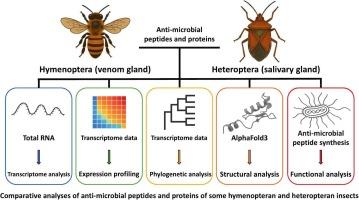Comparative analyses of venom and salivary gland-specific anti-microbial peptide and proteins of some hymenopteran and heteropteran insects
IF 4.3
3区 环境科学与生态学
Q2 BIOCHEMISTRY & MOLECULAR BIOLOGY
Comparative Biochemistry and Physiology C-toxicology & Pharmacology
Pub Date : 2025-08-12
DOI:10.1016/j.cbpc.2025.110326
引用次数: 0
Abstract
To test the hypothesis that the expression profiles, evolutionary patterns, and functionalities of anti-microbial peptides (AMPs) and proteins in some hymenopteran and heteropteran species are influenced by their distinct ecological traits, we conducted venom and salivary gland-specific transcriptome analyses. We compared the expression and evolutionary patterns of anti-microbial peptide and proteins across 22 hymenopteran and 9 heteropteran species. Additionally, we investigated the structural properties of selected defensins and assessed their anti-microbial and hemolytic activities. Defensin expression in social wasps from the family Vespidae was higher than that from the family Apidae and in solitary hunting wasps. Among heteropterans, only 2 species C. lectularius and G. rubrolineatum showed higher transcript levels than any others examined. Notably, the social wasp V. flaviceps and the phytophagous heteropteran G. rubrolineatum exhibited the highest levels of defensin expression among the hymenopteran and heteropteran species studied, respectively. Most anti-microbial peptide and proteins, with the exception of peptidoglycan recognition protein-SC2 in hymenopteran species, exhibited evolutionary patterns that were distinct from the typical hymenopteran and heteropteran lineage structures. Among the defensins derived from hymenopteran and heteropteran species, as well as the traditional antibiotics tested, the defensin from the phytophagous heteropteran G. rubrolineatum exhibited the strongest Gram-positive bacteria-specific anti-microbial activity. These findings provide valuable insights into the evolutionary dynamics and functional diversity of hymenopteran and heteropteran anti-microbial peptide and proteins and may contribute to the development of novel AMP-based strategies as promising alternatives to conventional antibiotics.

膜翅目和异翅目昆虫毒液和唾液腺特异性抗菌肽及蛋白质的比较分析
为了验证膜翅目和异翅目动物中抗菌肽和抗菌蛋白的表达谱、进化模式和功能是否受到其独特生态性状的影响,我们进行了毒液和唾液腺特异性转录组分析。我们比较了22种膜翅目和9种异翅目昆虫抗微生物肽和蛋白质的表达和进化模式。此外,我们研究了选定的防御素的结构特性,并评估了它们的抗微生物和溶血活性。防御素在蜂科群居黄蜂和独居狩猎黄蜂中的表达量均高于蜂科。在异翅目动物中,只有2种lectularius和G. rubrolineatum表现出较高的转录物水平。值得注意的是,在膜翅目昆虫和异翅目昆虫中,黄蜂和植食性异翅目昆虫的防御素表达水平最高。除了膜翅目中肽聚糖识别蛋白- sc2外,大多数抗微生物肽和蛋白的进化模式与典型的膜翅目和异翅目谱系结构不同。在膜翅目和异翅目以及传统抗生素中,来自植食性异翅目G. rubrolineatum的防御素表现出最强的革兰氏阳性细菌特异性抗菌活性。这些发现为膜翅目和异翅目抗微生物肽和蛋白质的进化动态和功能多样性提供了有价值的见解,并可能有助于开发新的基于amp的策略,作为传统抗生素的有希望的替代品。
本文章由计算机程序翻译,如有差异,请以英文原文为准。
求助全文
约1分钟内获得全文
求助全文
来源期刊
CiteScore
7.50
自引率
5.10%
发文量
206
审稿时长
30 days
期刊介绍:
Part C: Toxicology and Pharmacology. This journal is concerned with chemical and drug action at different levels of organization, biotransformation of xenobiotics, mechanisms of toxicity, including reactive oxygen species and carcinogenesis, endocrine disruptors, natural products chemistry, and signal transduction with a molecular approach to these fields.

 求助内容:
求助内容: 应助结果提醒方式:
应助结果提醒方式:


